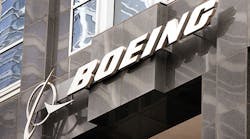Boeing Co. knew months before a deadly 737 Max crash that a cockpit alert wasn’t working the way the company had told buyers of the single-aisle jetliner.
But the planemaker didn’t share its findings with airlines or the Federal Aviation Administration until after a Lion Air plane went down off the coast of Indonesia in October, according to a Boeing statement Sunday as it provided additional details of an issue that first came to light last week. The accident occurred after erroneous readings by a single angle-of-attack sensor triggered software that pushed the jet’s nose down until pilots lost control.
Boeing’s latest disclosure raises new questions about the 737 Max’s development and testing -- and the company’s lack of transparency. The alert was supposed to flash when two angle-of-attack vanes sent conflicting data about the relation of the plane’s nose to the oncoming air stream. Boeing had told airlines and pilots that the so-called AOA disagree warning was standard across the Max fleet, as on a previous generation of 737 jets.
The software delivered to Boeing linked the signal with a second cockpit gauge -- available for a fee -- that displayed the readings from the two vanes. As a result, the AOA disagree light, which warned pilots of issues with the sensors, functioned only for customers that purchased the optional indicator.
“The question I have is just like we asked them in Reno, ‘Is that all there is?’ That’s the biggest question,” said Jon Weaks, head of the Southwest Airlines Pilots Association, referring to a meeting union leaders had with Boeing after the Lion Air crash. “It’s obviously troubling that here is something else Boeing didn’t get to us.”
FAA Criticism
The inactive alert was later deemed to be “low risk” by the FAA’s Corrective Action Review Board, the regulator said Sunday. “However, Boeing’s timely or earlier communication with the operators would have helped to reduce or eliminate possible confusion,” the FAA said.
Boeing engineers discovered the discrepancy “within several months” of the initial Max deliveries in May 2017, the company said. The disclosures followed criticism from airlines and crash victims’ relatives that Boeing hasn’t been forthcoming about issues with the 737 Max, which has been grounded since a second crash in March, in Ethiopia.
The two disasters killed 346 people.
The manufacturer’s own experts reviewed the issue and “determined that the absence of the AOA Disagree alert did not adversely impact airplane safety or operation,” according to the Boeing statement. The company’s review board decided the setup was acceptable until the two alerts could be unlinked with the next planned software update for the plane’s display system.
Airline Discussions
Rockwell Collins, which was acquired last year by United Technologies Corp., provides the cockpit displays and flight-control computers for the 737 Max. Another United Technologies division makes the angle-of-attack vanes for the plane.
United Technologies referred questions to Boeing.
Boeing fell 2.7% to $366.45 before the start of regular trading Monday in New York as U.S. stock futures slumped on trade-war anxiety. Through Friday, Boeing had dropped 11% since the Ethiopia crash. United Technologies declined 2.2% to $138.55 in premarket trading Monday.
The Chicago-based planemaker said its senior leadership wasn’t involved in the review and first became aware of the issue after the Lion Air accident. Boeing also broke the news of the glitch to Max operators such as Southwest Airlines Co. in the aftermath of the initial crash.
“Why weren’t the manuals changed? Until after Lion Air, our manuals said that worked,” Weaks said. “You can’t blame Southwest because that’s the information they had from Boeing. We don’t know what we don’t know.”
Boeing said it also told the FAA that company engineers had identified the issue in 2017, along with the findings from their internal review process. In December, a safety review board convened by the manufacturer confirmed that the absence of a functional AOA disagree light didn’t present a safety issue.
Software Update
Boeing briefed the FAA’s Seattle aircraft certification office in November, and the information was forwarded to the agency’s Corrective Action Review Board for evaluation, an FAA representative said Sunday. The panel determined the issue to be “low risk,” and said Boeing would have to fix it as part of an overall package of enhancements to the Max in response to the Lion Air accident.
Before the Max returns to service, Boeing plans to issue a software update that will allow the AOA disagree light to operate as a standalone feature.
Boeing has separately been working to finalize a redesign of the software, known as MCAS, that was mistakenly triggered by the faulty sensor readings. The last major milestone is an FAA certification flight that the company expects to conduct shortly.
By Julie Johnsson, Ryan Beene and Mary Schlangenstein




